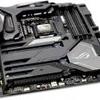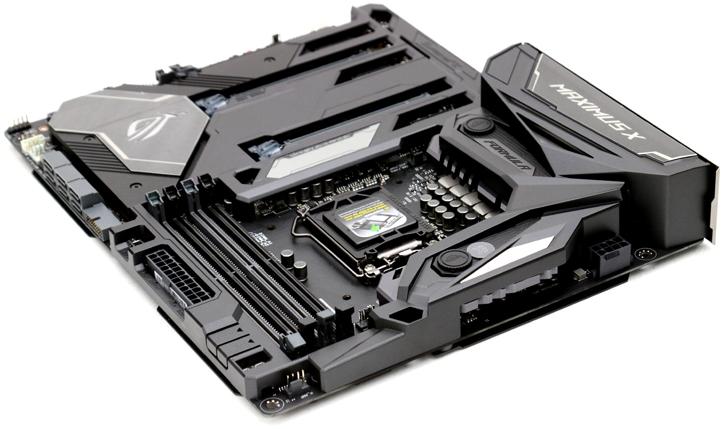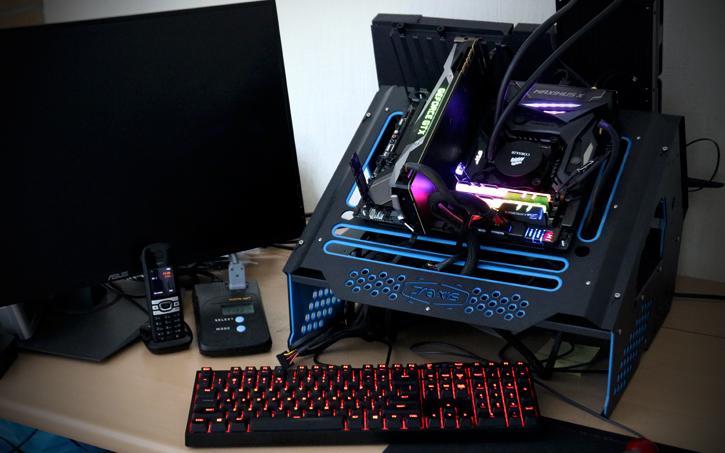Final Words & Conclusion
Conclusion
The one thing you can say about the new X Formula is that it is an amazing looking motherboard. To appreciate the motherboard you do need to see it powered on though! The gorgeous LED lighting system with the shielded black/grey design elements combined with the OLED display honestly kick ass. Not everything is perfect though, so let's first start with some remarks. This is a product selling in the 449,- Euro range and comes with just a single Gigabit Ethernet jack. I mean, where's the 5Gbit Aquatica Ethernet jack? Secondly, while it's great to see 5G WIFI included, ASUS opted for the cheaper Realtek version over the Qualcomm one, the latter is just overall much better. And thirdly, storage. You can argue if six SATA ports are enough... for most, yes. But again, in this price range that feels a little limited. We like the fact that the board can house two M.2. SDDs, ASUS, however, needs to step away from that hideous vertical M.2 SSD mount, that's just 'not done'. A DIMM.2 solution for M.2 SSDs would have been preferred. For the rest of it, it's all good though. Lovely good BIOS options and GUI, good tweaking, awesome looks and the overall performance might have been a slight notch below the baseline, but when tweaked this thing is seriously fast with the right processor. As mentioned, the board sits in a € 449,- and just over 500 USD price category. I do hope it drops a little more as the board itself, aside from looks and design, remains standard features wise. But it's such a nice board though as all main features are there as well as the performance and, sure enough, it tweaks as well as the others also. Really all Z370 boards perform roughly within the same 2% margin of error with an exception here and there. That goes for overclocking and tweaking as well, of course, the denominator here is the processor and not so much the motherboard. Overclocking wise we can reach 5.0 easy and 5.2 GHz on all six cores 100% stable on our sample, but we've also seen other CPU samples hardly reach 4.8 GHz. But it is around this range with the 8600k/8700k processors. The platform (Z370/Coffee Lake) also manages heat and power consumption at very acceptable levels.
Performance & tweaking
Once tweaked we noticed that the six cores like a bit of extra voltage, we expect all-core tweaks in the 5.1~5.2 GHz marker to need ~1.40 Volts on the processor. While that does increase power consumption, it wasn't something that scared me away. Some platforms and procs will also be able to manage a lower voltage. We tried this board with the CPU at 1.425 volts / 5.2 GHz frequency ranges and it reached a scary 90 Degrees C for that 5.2 GHz (all cores though), and that is tricky. We did use an ES sample, perhaps the final retail product can do with a little less juice. If you plan a tweak at that 5 GHz marker then remember my remarks on cooling, you will need LCS, that or a very good heat-pipe cooler. Again, we have been using an ES sample so I cannot say anything conclusive on the final retail products (these might run a tiny bit cooler). The infrastructure that Z370 offers is easy to use, you increase the CPU voltage and multiplier and you are good to go. Another plus for the Intel platform is that over the years they have been able to refine their memory controllers, pop in anything XMP 2.0 and you have a 90% chance it'll work straight out of the box with very fast memories. Keep in mind that all our tests are performed at 3200 MHz DDR4, similar to Ryzen and Threadripper to remain objective and for fair play on both sides.
Power consumption
Z370 with a six core, twelve thread proc equates to a 95 Watt TDP processor. With the system at idle with a GeForce GTX 1080 installed / 16 GB memory / SSD and the Z370 motherboard, typically you will hover at roughly 50 Watts in IDLE. The board is within the baseline of the rest of the tested Z370 motherboards. When we stressed the processor 100% we reach roughly 150 Watts with the 6-core 8700K part overall. When we game we hover at ~250 Watts with the GeForce GTX 1080, but obviously that factor is dependent on the type of graphics card you use of course and sure, most games certainly do not utilize the six CPU cores. Overall I have no worries here.
DDR4 Memory
For Coffee Lake (8th Gen Intel procs) DDR4 may be clocked a notch faster at 2400/2667 MHz as per Intel reference. We always say, volume matters more than frequency. A 3200 MHz kit, for example, is more expensive but does offer better bandwidth, the performance increases in real-world usage will be hard to find. Unless you transcode videos over the processor a lot. As always, my advice would be to go with lower clocked DDR4 memory with decent timings, but get more of it. Don't go for 8 GB, get four DIMMs and, in total, a minimum of 16 GB. The reason we test at 3200 MHz is simple, we do the same for AMD Ryzen and want to create a fair and equal playing ground for both.
Final words
The Maximus X Formula is a motherboard that I adore just for the way it looks. The LED system is brilliant and the OLED screen is just incredibly funky. However, the features overall are pretty standard compared to the competition. I mean two M.2 slots and 6x SATA. You do get a nice shield, OLED screen, AC WIFI and the liquid cooling block on the VRM area of course, but at 449,- bucks really, where's my 5G Ethernet jack and some more storage options? Also, that vertical M.2 connector is a no-no. I would have happily traded in the DIMM.2 at the cost of two DIMM slots personally. It, however, has got to be one of the best looking Z370 motherboards. The board kicks in with just the right amount of RGB LEDs, and once activated it's just a completely different board to look at. The LEDs give the product really nice looks. All RGB configurable of course and you also get to add more LED strips to the mobo connector and sync it all up with ASUS SYNC software. Connectivity wise, in terms of PCIe slots for your graphics subsystem you are looking at a full x16 Gen 3 lanes for one graphics cards. The second and third PCIe slots share their lanes with the first one, ergo you'd end up at a configuration like x8/x8. The fourth x16 slot, in fact, is an x4 slot which draws its lanes from the chipset and is shared with an M.2 slot. We expect most unlocked Coffee Lake CPUs to be able to manage the 5 GHz domain on all cores with exceptions running up towards 5.2 GHz (all-core). I base this metric on high-perf air coolers and liquid cooling. From there onwards you are looking at proc ASIC quality and cooling being the more important denominator. Concluding, the Formula is a magnificent looking product with some nice but fairly normal features. The icing on top of the cake is the included liquid cooling block for the VRM area, the OLED screen, RGB and shield design. At 449,- the price tag is high, but the cooling block simply is responsible for most of that. With mono-blocks becoming more popular, I do not know if many people would actually use the EK block at all or find the price premium with the extra investment. Perhaps it is time for ASUS to move away from these VRM area liquid cooling blocks and use that money for other extra features, as personally, I do not see the value in it anymore.
The ROG Maximus X Formula, however, is an exquisite partner for your Coffee Lake processor. If you are in need of that upgrade to a new platform with all the new technologies, hey this one comes recommended by Guru3D.com. For the quality build and fantastic looks, this piece of hardware is a recommended Guru3D.com product, but it's priced rather steeply alright.
** This review and benchmarks have been performed prior to the new January CPU bug patch. Performance figures might differ/shift on CPU and SSD in the future **
Handy related downloads:
- Sign up to receive a notice when we publish a new article
- Or go back to Guru3D's front page.




